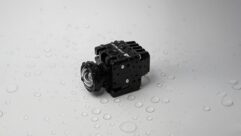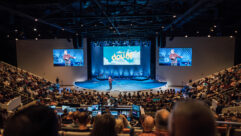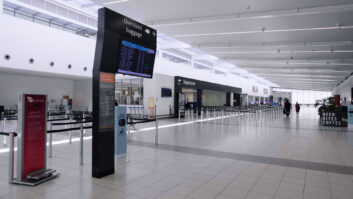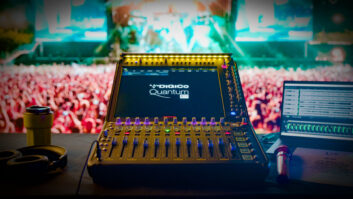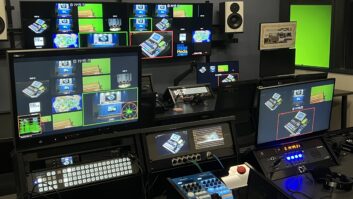A Tale of Two Physicists
Mar 20, 1997 12:00 PM,
Emily Thompson
The careers of Sabine and Knudsen, 30 years apart, show the origins and course of acoustical consulting in America.
In 1931, the Chicago-based Institute for Research published Careers, a series of pamphlets dedicated to answering “Youth’s Inevitable Question: ‘What Shall I Be?'” Each installment featured a particular career opportunity. Banking, aviation, animal husbandry, hotel management and industrial relations were among the many selections. The pamphlet on acoustical engineering described “innumerable opportunities” in this “pioneering profession,” largely because of the fact that architects “have been thoroughly won over to the science of acoustical engineering as an indispensable element in the design of a building.”
The brochure listed the numerous universities offering courses in architectural acoustics, including Harvard, MIT and UCLA, and then offered advice on the kind of employment the student of acoustics could seek upon graduation. Architectural and engineering contractors, companies that made acoustical building materials and AT&T were all potential employers. The pamphlet continued: “In the course of time, as he gains experience and acquires ability, the acoustical engineer may develop into a consulting engineer in acoustics. This branch of the profession, however, at the present time, is composed mostly of college professors who possess a highly specialized knowledge of acoustics.” (Institute for Research, 1931.) Although the writer of the pamphlet used the masculine pronoun, the text pointed out, under the heading “Opportunities for Women,” that, “While no statistics are available to indicate that women have entered upon the profession of acoustical engineering, there appear to be no valid objections to their engaging in this work.” (Institute for Research, 1931.)
The first of these consulting professors Careers acknowledged, was Wallace Sabine of Harvard. Indeed, although several notable nineteenth-century figures (such as physicist Joseph Henry and architect Dankmar Adler) had occasionally provided useful advice on matters acoustic, the profession of acoustical consulting had really only arisen in the 30 years that had passed since Sabine had carried out his foundational work at the turn of the century. Circa 1930, when the Careers pamphlet appeared, perhaps the most active consultant was Vern Knudsen of UCLA. By contrasting the consulting careers of Sabine and Knudsen, we can begin to understand not only the origins of the profession of acoustical consulting in America, but also the changing perceptions about the propriety of commercial consulting by acoustical scientists.
Wallace Sabine: reluctantly remuneratedMost readers of S&VC are already familiar with the details of Wallace Sabine’s life and career; thus they will be sketched only briefly here. Sabine was born in Richwood, OH, in 1868. He learned to love physics at Ohio State University under the tutelage of Professor Thomas Corwin Mendenhall. After graduating in 1886, he moved to Boston with his mother and sister to continue his studies at Harvard. In the physics department at Harvard, Sabine worked with John Trowbridge on problems in electricity, and he taught introductory laboratory courses.
Although he never did obtain his Ph.D., in 1895 Sabine was appointed assistant professor. Soon thereafter, Harvard’s president, Charles Eliot, asked the young professor to undertake an investigation of architectural acoustics in order to recommend a way to improve the sound of the auditorium in the university’s new Fogg Art Museum. The new lecture hall was so reverberant that classes could not be held there.
Sabine devoted several years to this project, studying not just the Fogg lecture room, but spaces all over campus and throughout Cambridge and Boston. The time and effort Sabine devoted to this problem, as well as his particular method of approach (he considered the reverberant sound as a sort of field of energy rather than a geometric pattern of waves), led him to a powerful solution to the long-standing problem of controlling the behavior of sound in rooms. He developed a simple formula that enabled one to calculate from design parameters – that is, in advance of actual construction – the amount of reverberation that would be present in a proposed space or in a proposed modification to a poor sounding place.
Sabine’s accomplishment was made public when he worked with the architectural firm of McKim, Mead and White on its design for Symphony Hall in Boston. At the time of Symphony Hall’s opening, in 1900, the Musical Courier reported: “If Mr. Sabine has mastered the secrets of acoustical construction … then not only is fame his, but also fortune.” The commercial potential of Sabine’s formula was clearly and immediately apparent.
How did Sabine deal with the commercial implications of his new-found knowledge? These implications constituted a problem for the physicist. Sabine believed that money held the power to corrupt his science as well as his scientific reputation, and he struggled throughout his lifetime to do the right thing, to achieve a proper balance between his science and his “fame and fortune.”
In the years following his work for McKim, Mead and White, Sabine’s technical advice was eagerly sought by numerous architects. By 1916, at least 85 different firms had sought his services. For a typical consultation, Sabine charged a fee of $200, which covered a study of blueprints, a visit to an extant building in some cases and recommendations for design or correction that could be executed by hired contractors. As Leo Beranek has shown, Sabine’s research notebooks indicate that in 1909 he earned at least $2,700 from consulting at a time when his Harvard salary was $4,500. This constitutes substantial supplemental income; still, Sabine hardly maximized his opportunity to increase his earnings.
For example, Sabine never patented his formula or technique. He felt that the formula, as a piece of scientific knowledge, should appropriately be placed in the public domain, available for all to use freely. In 1911, Sabine suffered for his altruism when a man named Jacob Mazer applied for, and almost received, his own patent on what was clearly the “Sabine method” of acoustical correction. Not only did Sabine make his formula and techniques freely available to others, but often, when he applied this knowledge himself to architectural problems, he simply refused payment. Sabine believed that his $200 fee should be paid by a building’s owner, not by the architects commissioned to design or improve that building. When a check was received from an architect’s office, it was respectfully returned. When a consultation provided a particularly interesting problem, a situation from which Sabine learned more about the behavior of sound, here, too, he was reluctant to accept remuneration.
One client, Winthrop Ames, recalled, “I was very much impressed with the complete absence of any commercial instinct in Professor Sabine’s makeup. While he went to great trouble and pains to help us solve our problems, he always gave us the impression that our problems were so interesting that it was we who were conferring a favor upon him by giving him an opportunity of helping us solve them.”
Another client, ultimately forced to solicit a bill from Sabine, concluded: “although you are a good expert on sound, you are not a good expert on how to charge for services.”
It is also clear that Sabine found it difficult to charge clients he had come to know personally; a gentlemanly code of ethics or behavior seemed somehow to conflict with the commercial origins of these new acquaintances. Sabine worked a great deal for, and formed real friendships with, the architects Ralph Adams Cram and Bertram Goodhue, of the firm Cram, Goodhue and Ferguson. Sabine felt honored to work with and come to know such eminent men, and he was uncomfortable accepting payment from them.
In 1912, he offered advice on some problems associated with Cram’s Cathedral of St. John the Divine in New York. When Cram submitted a check, Sabine politely returned it, explaining that he was “gratified” to render services without charge. In a 1910 letter to architect Russell Sturgis, Sabine indicated that he often found “embarrassing” the commercial aspects of his work. Although over the years he did clearly accumulate large sums of money from his consulting work, he was never entirely comfortable with the sale of his expertise in this way. (Sabine’s letter to Cram is found in The Wallace Sabine Correspondence Files at the Riverbank Acoustical Laboratories of the Illinois Institute of Technology Research.)
In addition to consulting with architects on projects, Sabine also was offered compensation for and subsidization of research on sound-absorbing materials by the manufacturers of those materials. Sabine’s first venture into the commercial world of the building materials industry was his most satisfactory. In 1911, Ralph Adams Cram introduced Sabine to a ceramic craftsman named Raphael Guastavino. Guastavino manufactured and installed timbrel tile vaulting, a building technology (developed by his father in Spain and subsequently brought to America) that made possible the magnificent domes and immense spans of such turn-of-the-century public spaces as the immigration facilities at Ellis Island and Neo-Gothic churches such as Cram’s Cathedral of St. John the Divine.
Cram suggested that Sabine and Guastavino work together to develop a vaulting tile that would be more sound-absorbent than the model then in use.
The collaboration of the two men proved highly successful. Guastavino devised new “recipes” for tile with suggestions from Sabine, and the physicist tested the absorptivity of the new tiles. After about two years of development, the Guastavino Company formally added an acoustic tile, called “Rumford,” to its line of products. (Rumford tile was later superseded by “Akoustolith” tile, the product of continued Sabine-Guastavino collaboration.) Sabine wrote to Cram that the results of his work with the tile manufacturer had exceeded his expectations, and he commented with pleasure on how Guastavino showed no interest in “exploiting” their relationship in inappropriate ways.
This arrangement was rewarding for Sabine in ways not just abstract. As the contract drawn up by the two parties indicates, Sabine was paid an up-front sum of $3,000 for his work with Guastavino. In addition, he was assigned a royalty of $0.05 per square foot of material actually used in construction. No direct record of royalty payments made to Sabine has been located, but calculation based upon the surface area of spaces in which the new tile was installed indicated that such payments must have been substantial. The vaulting of Newark’s Temple B’Nai Jeshurun, for example, appears to have consumed about 35,000 ft2 (3,251 m2) of Rumford tile, which, at 5 cents per square foot, would have generated a royalty of $1,750. Records for other projects executed during Sabine’s lifetime suggest royalties ranging from $30 for small projects, such as schoolrooms, to well over $1,000 for other large chapels and churches.
The contract further stipulated that if the materials resulting from the partnership be patented, Sabine’s royalty would increase to 10 cents per square foot. Guastavino and Sabine did patent the tiles they developed, but Sabine declined the increased royalty, preferring instead to keep down the cost of the tile and thus promote its use by architects.
Sabine found his work with Guastavino highly satisfactory. Here, as with his consultations for architects, he interacted one-on-one with a man he admired. This relationship of mutual respect was very profitable, too; it was possible for Sabine, under these circumstances, to accept what he called a “moderate return” from his scientific expertise.
What about less satisfactory experiences? Sabine’s encounters with manufacturers of lime and gypsum plasters indicate what was unacceptable about contracted industrial research. Around 1914, these plaster producers were competing for sales, and each asserted the acoustical superiority of their product. Manufacturers of both types of plaster asked Sabine to carry out research, which, each was confident, would prove scientifically that its own product was best at absorbing sound. Sabine responded that he was already engaged in an independent study of the transmission and reflection of sound by various wall surfaces, and he simply ignored the writers’ offers to provide materials free of charge. He felt acceptance of such an offer, even if it did not actually lead to bias, would give the appearance of bias, which was equally unacceptable to him.
Sabine undertook the kind of investigation that the manufacturers had sought, but he did it at his own expense. How was he to finance this increasingly expensive research, as more and more products appeared on the market, each asserting its acoustical superiority? This problem was almost miraculously solved for Sabine, and the solution came in the age-old package of a beneficent patron.
At the time of his death in 1919, Sabine was preparing to move his acoustical investigations into a new research laboratory designed and built exclusively for him by a wealthy manufacturer named Colonel George Fabyan. Fabyan lived west of Chicago on a country estate called Riverbank. He had a hobby of deciphering secret codes, particularly the “bilaterally coded” messages that he and others believed that Francis Bacon had placed in the first printed edition of the plays of William Shakespeare. One such message described a small cylindrical device wrapped by stretched wires. When the wires were sounded, the cylinder was to levitate. Fabyan had the device built, and when it didn’t levitate, he consulted a brother at Harvard to find out why it had failed. The brother referred him to Wallace Sabine.
Sabine’s response is unknown, but through their correspondence, Fabyan became interested in Sabine’s work. When the physicist described how he had to carry out his experiments late at night in order to minimize the interference of city noise, even though he worked deep within the sub-basement of the Jefferson Physical Lab at Harvard, Fabyan generously offered to build an acoustical laboratory for him at Riverbank, far from the disturbances of traffic, trains and city nightlife.
This offer came in the midst of the First World War, and Sabine was at that time more concerned with military aeronautics than acoustics. After the armistice of November 1918, however, with his wartime service complete, Sabine began calibrating the organ that was to be installed at the new laboratory. He was working on this project when a long-neglected illness took his life. The Riverbank facility, dedicated to the memory of Wallace Sabine, was placed under the direction of his cousin Paul Sabine, also a physicist, and became an important center for the testing of acoustical materials and products. The Riverbank Laboratory also introduced a young physicist named Vern Knudsen to the field of architectural acoustics.
Vern Knudsen: enthusiastic entrepreneurVern Knudsen was born in Utah in 1893, the son of Scandinavian immigrants. While an undergraduate at Brigham Young College, he worked with Harvey Fletcher, a physicist who had received his Ph.D. under the renowned Robert Millikan at Chicago. Fletcher left Brigham Young for the Western Electric Laboratories (later to become Bell Labs) in 1916. Several years later, Knudsen, who had since graduated, followed him there.
After a year in industry, Knudsen decided to pursue graduate studies. As he recalled, “Chicago was the place to work for that coveted Ph.D. degree in physics.”
For his thesis, Knudsen studied the sensitivity of hearing using the electroacoustic tools – vacuum-tube amplifiers and telephone receivers – he had employed at Western Electric. Knudsen received his doctorate in 1922; he declined an offer to return to the Western Electric telephone laboratory, accepting instead an instructorship at the University of California Junior College at Los Angeles. Before heading west to the Southern Branch, as the campus was known, Knudsen joined some Chicago professors on an outing to the Riverbank Acoustical Laboratory.
Fabyan was most interested in showing his guests the secret messages in his Shakespeare folios, but for Knudsen, the visit to the acoustical laboratory was much more interesting. After touring the facility and hearing of Wallace Sabine’s work, Knudsen set out to obtain the recently published Collected Papers of Sabine to learn all there was to learn about architectural acoustics and to make this his research specialty.
Upon arriving in Los Angeles, Sabine’s Collected Papers in hand, the young professor soon learned that neither space nor funding for acoustical research existed. He resourcefully approached the Los Angeles Board of Education, and Knudsen soon had all of the (apparently bad-sounding) high school auditoriums of the city at his disposal for experimentation.
He also took a step toward bridging the gap between his academic salary of $2,400 and the $4,000 offer from Western Electric he had declined. Knudsen was paid $100 to $200 for each consultation, and he acknowledged that he had planned on obtaining just this kind of supplementary income when he decided to accept the lower-paying academic position. Whereas Sabine almost accidentally came upon his extra income from consulting and accepted it in a highly qualified manner, Knudsen counted on it and accepted it without hesitation. Further, whereas Sabine sought and formed personal relationships with his clients, Knudsen did not often socialize with the architects who hired his services; they were clients, not friends.
In addition to consulting, Knudsen – like Sabine before him – also analyzed the sound-absorbing properties of building materials. He initially improvised a laboratory in a men’s room on campus. Then, in 1925, the Cal-Acoustic Plastering Company built Knudsen a new research facility. This lab was built not on campus, but on Central Avenue, in the heart of the city’s manufacturing district. Sabine had been uncomfortable accepting only materials from commercial suppliers, worried as he was about the appearance of bias; Knudsen found it unproblematic to work in a laboratory built by industrial sponsors, a lab located in the midst of their commercial environment. Perhaps his stint at Western Electric, where he worked in an industrial setting filled with “real scientists” like Harvey Fletcher doing “real science,” helped prepare Knudsen for the mixture of the scientific and commercial environments he encountered, in fact sought to create, in Los Angeles.
Knudsen’s apparent ease in creating or accepting these kinds of commercial opportunities should not, however, leave the impression that he was a master businessman. Although seemingly more savvy than Sabine, Knudsen, like Sabine, was ultimately unaware of the true market value of his knowledge.
The advent of sound motion pictures in Hollywood provided a lucrative market for acoustical expertise – more lucrative than a young physicist could imagine. In 1928, Louis B. Mayer hired Knudsen to create the proper acoustical environment on Metro-Goldwyn-Mayer’s two new sound-stages. Knudsen recalled that he had initially charged MGM about $100 a day, which he considered “very good pay” for a young assistant professor. But later, he was approached by Eddie Mannix, the business manager for MGM, who forthrightly confided that Knudsen had seriously underestimated the commercial value of his services. Mannix subsequently offered Knudsen a fixed sum of $2,500 for acoustical work on four additional MGM sound stages. This consultation took about 10 days of work, Knudsen later recalled; thus he enjoyed aconsiderable pay raise thanks to Mannix’s intervention.
Like Sabine, Knudsen had to be instructed by others on how best to profit from his expertise. Also like Sabine, that profit proved substantial. Add to the $2,500 from MGM probably similar payments from Warner Brothers, Fox, Paramount and other studios, and then add another $3,000, a retainer the Carrier Corporation paid to Knudsen when he helped them design the noise out of their soundstage air conditioning systems. Both scientists clearly improved their standards of living by taking their knowledge of acoustics beyond university walls. Although Sabine accepted his commercially derived fortune only with awkwardness and embarrassment, Knudsen enthusiastically welcomed these opportunities to supplement his income and research budget.
A modern scientistCareers may have been correct in identifying Sabine as the first modern acoustical consultant, but in many ways, his attitude toward consulting was far from modern. The brochure stretched the truth more than a bit when it claimed that his selfless dedication to creating a science of acoustics left him “probably a poorer man by thousands of dollars than he would have been if he had never attempted it.” However, Sabine’s lack of enthusiasm for commercially derived income and research support hardly served as a useful model for the youth of 1931 who hoped, one day, to make a living as acoustical consultants. Sabine was presented to the readers of Careers as a deeply dedicated, ethical, unworldly and pioneering seeker of truth, and, as such, he provided a moral exemplar to future acoustical engineers.
But perhaps the brochure would have done well also to tell the story of the energetic young professor at UCLA, the scientist who came of age in a world of commercially based science and who relished a world of commercial opportunity he was eager to claim as his own. Perhaps Vern Knudsen should also be recognized as another “first” modern acoustical consultant.
Thompson is assistant professor of history and sociology of science at the University of Pennsylvania.
Bibliography
Careers, The Institute for Research, 1931.
Leo L. Beranek, “The Notebooks of Wallace C. Sabine,” JASA 61, March 1977, pp. 629-639.
Leo L. Beranek and John W. Kopec, “Wallace C. Sabine, Acoustical Consultant,” JASA 69, January 1981, pp. 1-16.
William Dana Orcutt, Wallace Clement Sabine; A Study in Achievement, Plimpton Press, 1933.
Fred W. Kranz, “Early History of Riverbank Acoustical Laboratories,” JASA 49, February 1971, pp. 381-384.
Vern Knudsen and James V. Mink, Teacher, Researcher and Administrator: Vern O. Knudsen, UCLA Oral History Transcript, 1974.



